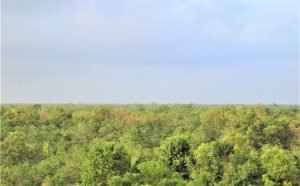
BY RAVINDER PAL SAINI
( IFS,RETIRED)
MEMBER, BOARD OF MANAGEMENT
CENTRAL FOREST UNIVERSITY, DEHRADUN
DEHRADUN, 18 AUGUST 2022
Mangroves Preserve the stability, Integrity, and beauty of The Biotic Community Of Sundarbans. There are 34 species of mangroves in Sundarbans. At Sudhanyakhali in Sundarbans Tiger Reserve an arboretum depicting all these species is there.

Mangrove, any of certain shrubs and trees that belong primarily to the families Rhizophoraceae, Acanthaceae, Lythraceae, Combretaceae, and Arecaceae; that grow in dense thickets or forests along tidal estuaries, in salt marshes, and on muddy coasts; and that characteristically have prop roots—i.e., exposed supporting roots. The term mangrove also applies to thickets and forests of such plants.

Respiratory or knee roots (pneumatophores) are characteristic of many species; they project above the mud and have small openings (lenticels) through which air enters, passing through the soft spongy tissue to the roots beneath the mud.
Mangroves are extremely important to the coastal ecosystems they inhabit. Physically, they serve as a buffer between marine and terrestrial communities and protect shorelines from damaging winds, waves, and floods. Mangrove thickets improve water quality by filtering pollutants and trapping sediments from the land, and they reduce coastal erosion.

Ecologically, they provide habitat for a diverse array of terrestrial organisms, and many species of coastal and offshore fish and shellfish rely exclusively on mangroves as their breeding, spawning, and hatching grounds. Because of their high salt tolerance, mangroves are often among the first species to colonize mud and sandbanks flooded by seawater, but an increase in coastal development and altered land use led to a decline in global populations.

Shoreline Protection: Mangroves protect shorelines from damaging storm and hurricane winds, waves, and floods. The dense root systems of mangrove forests trap sediments flowing down rivers and off the land. This helps stabilize the coastline and prevents erosion from waves and storms. They maintain water quality and clarity, filtering pollutants and trapping sediments originating from land.

Clean water: Mangroves protect both the saltwater and the freshwater ecosystems they straddle. The mangroves’ complex root systems filter nitrates and phosphates that rivers and streams carry to the sea. They also keep seawater from encroaching on inland waterways.

“If there are no mangroves, then the sea will have no meaning. It is like having a tree without roots, for the mangroves are the roots of the sea…”………….Thai Saying
“The mangrove forest sustains the people who sustain the mangroveforest…”, Pisit Charnsanoh, Yadfon Association, Trang, Thailand.

Advertisement:




























Add Comment